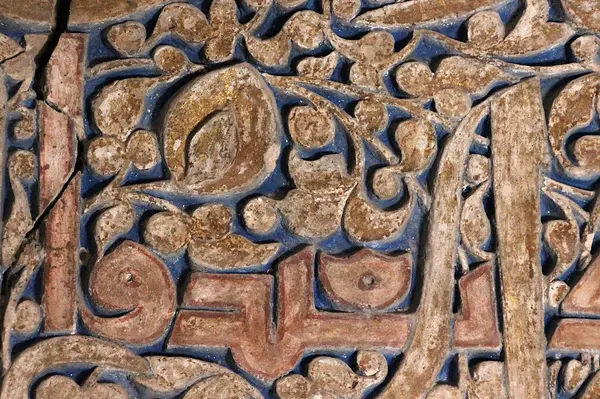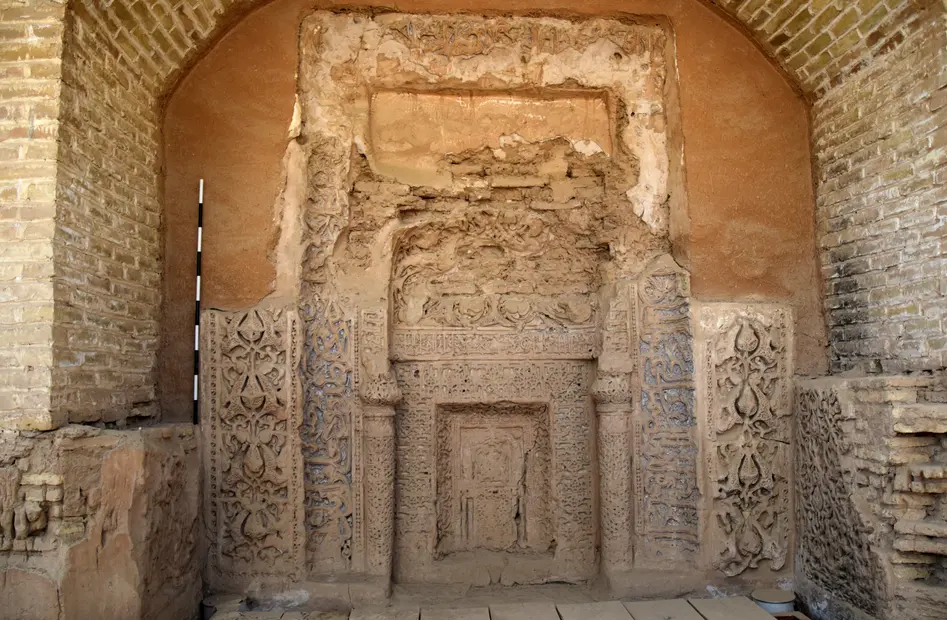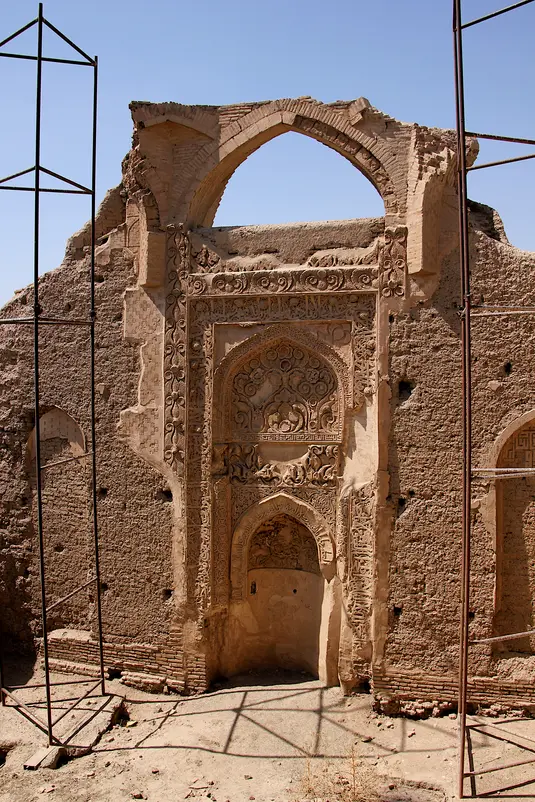Aesthetics of Stucco and Tiles, Research funded by the DFG
Subject
Artistic techniques and aesthetics of architectural decoration in medieval Iran have long been recognized as a topic of crucial importance in Islamic Art. The present project proposes a systematic research designed to achieve a deeper understanding of this field. It is based on information gathered in large-scale research of monuments with art historical and archaeometric research methods. The project focuses on monuments which were built or decorated between the 11th and 14th centuries (Seljuq and Ilkhanid periods).
Stucco, tiles and wall paintings appear on religious and secular monuments likewise: mosques and mausoleums, palaces and caravanserais. Although the Seljuq and Ilkhanid dynasties originated from regions outside Iran, they based their rule on an infrastructure rooted in Iran and in the Islamic cultures of the Middle East. The art and material culture of Iran during this period thus evolved from the legacy of pre-Islamic and Islamic Iranian civilizations. Both dynasties formed a uniquely productive climate for the flourishing of arts, crafts and architecture. While the Mongol invasion of the Iranian plateau is frequently interpreted as a major historical break, it appears that the material cultures of the Seljuq and Ilkhanid periods are closely interrelated. They were shaped not only by activities of the immigrated ruling dynasties and their followers, but also by indigenous traditions and political agendas of the local Iranian elites.

Goals of Research
The principal aim of the research project is to provide an understanding of the aesthetics of architectural decoration in the Seljuq and Ilkhanid periods. Assuming that these architectural revetments were not simply intended as an adornment, it is postulated that they functioned to highlight selected architectural elements and spaces in a specific manner, thus bolstering the devotional significance of architectural spaces.
Characteristics of function, meaning and artistic methods of architectural revetments determined the aesthetics of architectural decoration. Traditions in which artists and craftsmen had grown up as well as their ability to innovate contributed to the creation of architectural decoration. This elicits questions about the hierarchies of different media and materials, about the relations between aesthetics, functions and patronage of architectural revetments, and particularly about the methods and techniques that artisans used to design and execute architectural decoration.

Research Methodology and Results
Buildings located in different regions of Iran were examined with a focus on material and aesthetic features of (mainly interior) architectural revetments. Field research of monuments comprised detailed documentation connected with studies of historical contexts of c. one hundred monuments, and the collecting of samples from c. fifty buildings in order to identify properties of stucco and pigmentation and. Results of archaeometric analyses were collated with epigraphic and historiographic material in order to assess their historical context as well as aesthetic characteristics.
This way, regional characteristics of stucco production, possible characteristics and mobility of stucco workshops, and provenance of materials will be better understood. Ultimately, evidence for the dating of undated decorative stuccos can also be provided. On this basis, questions regarding function, aesthetics and meaning of stuccos, tiles and wall paintings are being discussed.
From the plethora of new materials and insights, some results can be summarized here as examples:
- Apart from the formal changes and innovations in individual elements and motifs, compared to the classical Abbasid period, the Seljuq period brought about a change in the overall organisation of stucco decoration: Friezes of repetitive designs became less important, whereas epigraphic bands in a variety of styles (Kufic and round scripts) became more frequent.
- The Saljuq period innovation in architectural forms, namely, large dome halls, implied new challenges for architectural decoration. The interplay of stucco relief and brick patterns became coherent in design and careful in detailed execution. Colouring was applied on selected parts.
- Among the technical innovations of the Saljuq and Ilkhanid periods, the use of gach-I kushta should be noted: Gypsum that is mechanically treated during its setting, which made it applicaple for the modelling of fine surface structures and as a coating.
- Inscriptions as part of stucco decoration were occasionally prepared with stencils, but frequently they were designed and drawn directly on the stucco surface. This can be concluded from traces of workmanship and from other features of inscriptions in Ilkhanid-period stucco decoration. This modifies the hitherto dominating view that calligraphed inscriptions were in all cases prepared with paper stencils and then transposed into stucco relief.
- Under Ilkhanid rule, it is possible to identify connections between different works of stucco decoration that can be explained from identical workshop traditions and workshop migration. These can be found in regional clustered but in some cases also over considerable geographical distance. In this respect, the monumental building project of the Mausoleum of Uljaytu in Sultaniya seems to have played a crucial part for the development and the distribution of new designs and techniques of decoration, which spread from here to other places. They can be observed in some richly decorated 14th-century buildings in the city of Yazd.
- In the transition from the Saljuq to the Ilkhanid period, no rupture but rather continuity can be observed in forms and techniques of stucco decoration. As an example, the Great Mosque of Faryumad can be quoted, where the principal phase of decoration has been re-dated to the mid-13th century on the basis of stucco inscriptions. However, the forms of decoration correspond strongly with examples from the 12th century. In other places, Ilkhanid-period stucco is easier to differentiate from Saljuq stucco: A tendency to increased three-dimensionality can be seen, which is technically rooted in the use of several layers of cut stucco and in separately applied elements.
- In the field of colouring, the use of pigments shows a tendency to economize with regard to technology and materials. There are cases in which stages of development can be dated: As an example, the change from ultramarine (lapis lazuli) to azurite for intense blue can be dated to c. 1300.
- In some buildings featuring Seljuq decorations and later modifications—such as the Masjid-i Jami? of Gulpayigan—the addition of tiles to stucco, along with repair layers using azurite as a blue pigment, reflects shifts in the tradition of revetment.
Such research has the potential to be applied in the preservation of ruined monuments, such as the Haftshuya Friday mosque and the Gar Friday mosque, or severely endangered monuments, such as the Afin Friday mosque and the caravanserai of Ribat-i Mahi.
The project enables a more comprehensive understanding of architectural decoration in medieval Iran. The interdisciplinary approach can help to bridge gaps between archaeology, cultural heritage conservation and the history of art.

Publications
In preparation or in press
Lorenz Korn, Ana Marija Grbanovic, Iman Aghajani and Moslem Mishmastnehi (eds.): Stucco in the Architecture of Iran and Neighbouring Lands: New Research – New Horizons. Proceedings of Conference held at the University of Bamberg, May 4-7, 2022, under review for publication with de Gruyter/Brill (Reihe: Art and Archaeology of the Islamic World).
In the same volume, the following six articles are authored by members of our research team:
- Lorenz Korn: “Introduction: Stucco in Iran and Neighbouring Lands. Reviving faded colours through art history”
- Iman Aghajani: “From Tradition to Innovation: Iranian Stucco Decoration from the Early Islamic Period to the Saljuq Era”
- Iman Aghajani and Majid Montazer-Zohoori: “Archaeological Studies on Islamic Stucco Decorations in the Storage of the National Museum of Iran”
- Ana Marija Grbanovic: “Some Remarks Concerning Uljaytu’s Mausoleum at Sultaniyya and its Architectural Revetments”
- Amir-Hossein Karimy and Holakooei: “Blue 'out of the blue': scientific studies on the blue pigments applied on Persian stucco”
- Moslem Mishmastnehi and Tomasz M. Stawski: “Crystals of Gypsum in the Hands of Masters: Interdisciplinary approach to understanding the Cha?ne opératoire of Seljuq and Ilkhanid Stuccoes”
Iman Aghajani: “Signaturen in der iranischen Architektur des 11. und 12. Jahrhunderts“, accepted for: Nikolaus Dietrich et al. (eds.): Tagungsakten Signaturentragende Artefakte. Schriften, Materialien, Praktiken im transkulturellen Vergleich, in the series Cultural Heritage: Materiality - Text - Edition (KEMTE), Heidelberg.
Iman Aghajani: “Reconsidering the so-called Madrasa-i Ni?āmīyya of ?argird: New Evidence of Iran's Earliest Ayvān-Mosques”, accepted for: Sandra Aube und Martina Massullo (eds.): Proceedings of the Conference Through the Lens of Henry Viollet: Islamic Monuments through an Undisclosed Archival Material (1904-1913 CNRS und BULAC, Paris, June 23, 2022.
Iman Aghajani and Lorenz Korn: “Stucco of the Seljuq Period in Iran, with a Focus on Dado Zones and Mihrabs”, in: Richard P. McClary (ed.): Stucco in the Islamic World. Studies of Architectural Ornament from Spain to India (Edinburgh Studies in Islamic Art), Edinburgh: University Press, 2025.
Ana Marija Grbanovic: “Towards a Comprehension of Ilkhanid Stucco Style(s),” in: Richard P. McClary (ed.): Stucco in the Islamic World. Studies of Architectural Ornament from Spain to India (Edinburgh Studies in Islamic Art), Edinburgh: University Press, 2025.
Ana Marija Grbanovic: “The Sujas Friday Mosque Stuccos: Seljuk or Ilkhanid?” accepted for: Robert Hillenbrand (ed.): Architecture of the Iranian World 1000-1250, Edinburgh: University Press.
Ana Marija Grbanovic: “Henry Viollet’s Photographic Documentation of Ilkhanid Stucco Revetments in Iran and its Significance for Art Historical Research,” accepted for: Sandra Aube und Martina Massullo (eds.): Proceedings of the Conference Through the Lens of Henry Viollet: Islamic Monuments through an Undisclosed Archival Material (1904-1913) CNRS und BULAC, Paris, June 23, 2022.
Ana Marija Grbanovic: “In Memoriam Hasankeyf: Some Remarks Regarding the Stuccos of Hasankeyf Monuments,” accepted for: Michelina di Cesare (ed.): Beitr?ge zur Islamischen Kunstgeschichte und Arch?ologie, vol. 9, Proceedings of the 16th Annual Colloquium of the Ernst Herzfeld Society, University La Sapienza, Rome, July 1-3, 2021
Ana Marija Grbanovic: “A Little Known Ilkhanid Stucco Repertoire: the Mir Zabir Mausoleum near Sirjan,” accepted for: Iran Journal of the British Institute for Persian Studies.
Parviz Holakooei, Amir-Hossein Karimy, Iman Aghajani and Lorenz Korn: “Further Light on the History of Masjed-e Jame? of Golpayegan based on the identification of colourants”, submitted for Archaeological and Anthropological Science.
Parviz Holakooei, Amir-Hossein Karimy, Ana Marija Grbanovic and Lorenz Korn: “Glaze composition in Persian architectural decoration from the 12th to the 14th century”, in preparation, to be submitted for Archaeological and Anthropological Science.
Amir-Hossein Karimy: Masjed-e Jame? of Golpayegan: sixty years of conservation activities in the mirror of archival documents, in preparation, to be submitted for Iran Journal of the British Institute for Persian Studies.
2025
Iman Aghajani: “The Friday Mosque of Faryūmad and Its Inscription: Evidence of Construction Activity during the Era of the Mongol Khans in Iran”, Iran: Journal of the British Institute of Persian Studies, 2025. Open Access. DOI: 10.1080/05786967.2025.2454707
www.tandfonline.com/doi/full/10.1080/05786967.2025.2454707
Moslem Mishmastnehi, Tomasz M. Stawski, Negar Eftekhari, Kathrin P. Schneider, Carmela Vaccaro, Iman Aghajani, Ana Marija Grbanovic and Lorenz Korn: “Unveiling the Craftsmanship and Knowledge Behind Iranian Stuccoes (11th -14th centuries): New insights from an archaeometric perspective”, Journal of Archaeological Science 177 (2025), 106199 Open Access: doi.org/10.1016/j.jas.2025.106199
2024
Parviz Holakooei and Amir-Hossein Karimy: Colourants on the Persian architectural decorations from the 11th to the 15th century, Archaeometry 66.3 (2024), pp. 600-617. doi.org/10.1111/arcm.12951
2023
Iman Aghajani, Maryam Moeini and Moslem Mishmastnehi: “Imāmzāda ?Abdallāh of Kūdzar, Iran: New Insights regarding its Architectural Revetments.”, in: Nicolò Marchetti et al. (eds.), Proceedings of the 12th International Congress on the Archaeology of the Ancient Near East, Vol. 2, Field Reports, Islamic Archaeology, Wiesbaden: Harrassowitz, 2023, pp. 819-835. Open Access: DOI:10.13173/9783447119030.819
www.harrassowitz-verlag.de/titel_7228.ahtml
Ana Marija Grbanovic: “Between Tradition and Innovation: The Art of Ilkhanid Stucco Revetments in Iran,” ín: Nicolò Marchetti et al. (eds.): Proceedings of the 12th International Congress on the Archaeology of the Ancient Near East, Vol. 2, Field Reports, Islamic Archaeology, Wiesbaden: Harrassowitz, 2023, Wiesbaden: Harrassowitz, 2023, pp. 763-778. Open Access: DOI: 10.13173/9783447119030.763.
www.harrassowitz-verlag.de/titel_7228.ahtml
Ana Marija Grbanovic: “Carved Letters, Designs and Ornaments: Ilkhanid Stuccos and the ?Signatures‘ of their Craftsmen,” in: Andrew Peacock et al. (eds.): Inscriptions of the Medieval Islamic World, Edinburgh: University Press, 2023, pp. 642-670.
Ana Marija Grbanovic: “The ?ljeitü Mihrab (1310; Isfahan): the Ilkhanid Stucco Chef-d’?uvre Re-Examined,” in: Markus Ritter and Nourane Ben Azzouna (eds.): Beitr?ge zur Islamischen Kunst und Arch?ologie 8, Wiesbaden: Reichert Verlag, 2023, pp. 177-196. DOI: 10.29091/9783752002355; ISSN: 1866-8550
Ana Marija Grbanovic: “Lost and Found: the Tiles of the Pir-i Bakran Mausoleum (1299-1313, Linjan, Isfahan),” Iran. Journal of the British Institute of Persian Studies 61.2 (2023; online publ. 05/2021), pp. 235-254. DOI: 10.1080/05786967.2021.1927141
www.tandfonline.com/doi/full/10.1080/05786967.2021.1927141
Ana Marija Grbanovic: “Ilkhanid Stucco Revetments in Iran, c. 1256-1335. Function, Meaning and Aesthetic Principles,” (c. 1500 pages), PhD dissertation (University of Bamberg 2022). published Open Access: Bamberg, University of Bamberg Press, 2023: https://fis.uni-bamberg.de/handle/uniba/90074 DOI: 10.20378/irb-90074.
Moslem Mishmastnehi, Alexander E. S. Van Driessche, Glen J. Smales, Alicia Moya, Tomasz M. Stawski: “Advanced Materials Engineering in Historical Gypsum Plaster Formulations”, Proceedings of the National Academy of Sciences of the United States of America 120 (2023), e2208836120. Open Access: doi.org/10.1073/pnas.2208836120
2022
Richard McClary and Ana Marija Grbanovic: “On the Origins of the Shrine of ‘Abd al-Samad in Natanz: The Case for a Revised Chronology,” Journal of the Royal Asiatic Society 32 (2022), pp. 501-534. Open Access:DOI: https://doi.org/10.1017/S1356186321000730
